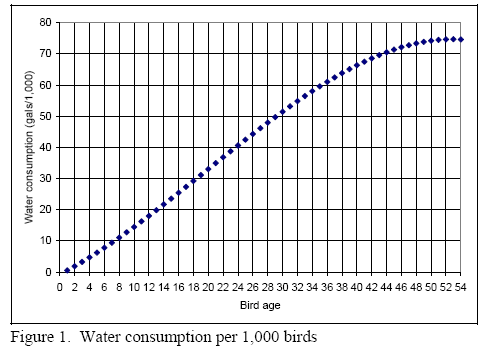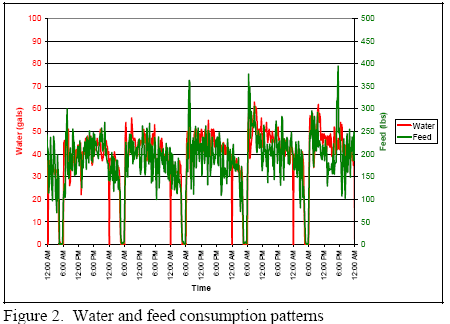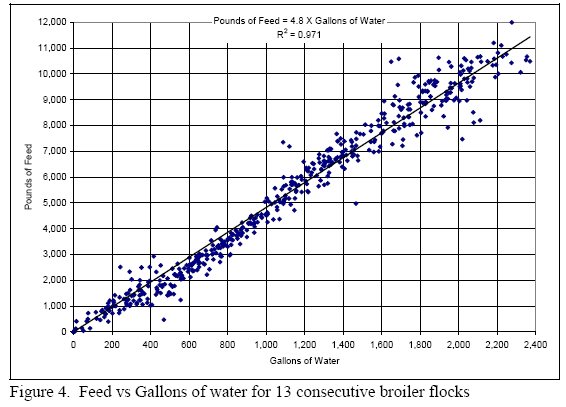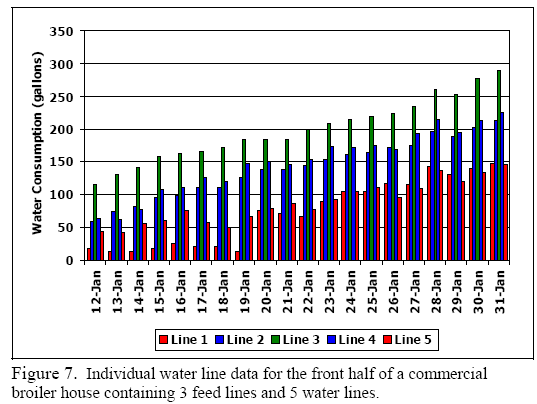Water consumption
Using Water Consumption as a Management Tool
Published: April 11, 2012
By: Dr. Mike Czarick, Dr. Brian D. Fairchild (The University of Georgia)
Water is considered an essential nutrient. While an animal can survive for a week or so without food, water deprivation can only be tolerated for a few days. Water is important for a variety of bodily functions that include but are not limited to nutrient transportation, body temperature regulation, lubrication of joints and organs, enzymatic/chemical processes including those related to feed digestion. A large number of factors can influencewater usage in the bird´s body and include environmental temperature, relative humidity, health status of the bird (especially intestinal health), diet formulation, presence or absence of feed, and even genetics. Because water consumption plays so many roles in the health and performance of a bird much can be learned by simply monitoring daily water consumption.
Daily water consumption increases with bird age (Figure 1). The relationship between bird age and water consumption (per 1,000 birds) is represented by the equation (Xin, et. al, 1994):
Water Consumption = (-2.78 + 4.70D + 0.128D2 - 0.00217D3) x 0.26
Birds that are heat stressed will consume more water than those kept at thermoneutral temperatures (comfort zone). Feed and water consumption are closely related (Figure 2). Birds that are not eating or do not have access to feed will not drink as much water as those that are eating. The relationship between feed and water consumption is approximately 1.8 lbs of water per pound of feed. This means that for every pound of feed eaten, 1.8 pounds or 0.22 gallons of water are consumed (Figure 4). Water consumption increases as activity level increases. During dark periods water consumption is significantly reduced (Figure 3), however it is not uncommon to observe some water drinking activity even after the lights are turned off. Diet can influence water consumption. Factors such as salt, energy content and added supplements can influence water consumption. Management factors that affect water consumption include water line height, water line maintenance (regular flushing and cleaning, as well as, water quality), drinker line location within the house and water pressure. Factors that could affect water pressure include line regulator, water filter cleanliness, well pump, and power outages.




When a broiler flock´s water consumption decreases it is almost always a sign of a problem (Figure 5). A reduction of water consumption will often show up before mortality, disease symptoms or production decreases, which can give growers advanced warning of impeding problems. Thus daily monitoring of water intake can be a useful management tool. Problems such as absence of feed, bird distribution, bird heat stress, or even health problems are also easy to pick up on through monitoring daily water consumption. Using at least two water meters per house can help identify when to put up migration fences and if too many birds are in one end of the house (Figure 6).


Many of the latest environmental controllers can accept multiple digital inputs allowing for the installation of multiple water meters. The fact that multiple water meters can be used has opened an entire new area of water monitoring; such as monitoring individual water lines. Monitoring individual water lines can provide answers to many questions such as:
1. Do birds drink the same off of all water lines in a broiler house? For example, do they use the inside lines more than the outside lines.
2. What daily management practices have the biggest impact on water consumption?
3. What other factors during the growout period affect water consumption?
2. What daily management practices have the biggest impact on water consumption?
3. What other factors during the growout period affect water consumption?

The monitoring of individual water lines may help to provide answers to these questions and more and should prove to be an efficient and accurate way of tracking bird performance. Currently, we are monitoring water usage on individual water lines on a big bird farm (56 day growout) and two small bird farms (38-42 day growout). Figure 7 illustrates the data collected from the individual water lines during a recent growout. It is apparent that individual water lines are utilized differently, but in general it appears that the inside water lines are utilized more than the outside water lines. This observation has been made on every flock monitored in the study.
Understanding how birds drink and the factors that influence their drinking patterns can help producers identify problems quickly before performance is negatively impacted. The data obtained from this study indicated line preference for the birds and that the preference changes as the birds get older. The information to be provided in future newsletters will demonstrate the effects that little changes in the way birds are managed can influence water consumption patterns between lines as well as the front and back of a house. The strong relationship between feed consumption and drinking water is providing valuable information to help us understand how management influences water intake and this will undoubtedly help producers manage their birds better and more efficiently.
This article was originally published at UGA Cooperative Extension Poultry Housing Tips Vol. 18 no.9, September 2006. Engormix.com thanks the authors for this contribution.
Related topics:
Authors:
University of Georgia
University of Georgia
Recommend
Comment
Share
University of Georgia
2 de noviembre de 2014
Unfortunately, there is not a lot of work that has been done in this area. The other issue is that the water flow during the first few days is extremely low and most water meters used in poultry facilities do not become accurate until about 6 or 7 days of age (depending on the water meter used).
I am not currently aware of any recent work in this area to provide extra information.
Recommend
Reply
17 de noviembre de 2014
Dear Sir,
The topic was very useful to me as i am a framer.In summer mainly heat stroke happen so how to overcome the problem plz explain.
Recommend
Reply
2 de noviembre de 2014
Dear sir,
thank you for your precious article
could you clarify if there is correlation between water consumption and feed intake during the first few days in baby chicks life as it is known that the chick starts to eat after it starts to drink which is called drinking reflex ..... could you provide me with any useful data about this.
Regards
Dr. Mohammed Naeem
Recommend
Reply

Would you like to discuss another topic? Create a new post to engage with experts in the community.











.jpg&w=3840&q=75)